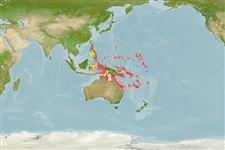>
Kurtiformes (Nurseryfishes, cardinalfishes.) >
Apogonidae (Cardinalfishes) > Apogoninae
Etymology: rubrimacula: From the Latin ruber, red, and macula, spot, in reference to the conspicuous red spot at the midbase of the caudal fin.
More on authors: Randall & Kulbicki.
Environment: milieu / climate zone / depth range / distribution range
Ecologia
marinhas associadas(os) a recifes; intervalo de profundidade 0 - 33 m (Ref. 33415). Tropical; 22°N - 28°S, 120°E - 178°E
Western Central Pacific: Ryukyu Islands south to Australia; Indonesia (Ref. 90102) east to Fiji Islands (Ref. 56673).
Comprimento de primeira maturação / Tamanho / Peso / Idade
Maturity: Lm 3.5 range ? - ? cm
Max length : 4.5 cm SL macho/indeterminado; (Ref. 33415); idade máx. registrada: 4 anos (Ref. 56673)
Descrição suscinta
Chaves de identificação | Morfologia | Morfometria
Espinhos dorsais (total) : 8; Raios dorsais (total) : 9; Espinhos anais: 2; Raios anais : 8; Vértebras: 24. Predorsal scales 4; preopercular edge serrate; preopercular ridge smooth to slightly crenulate; body depth 2.85-3.05 in SL; silvery blue-gray with 6 orange to orange-yellow stripes on head and body, those on body narrower than blue-gray interspaces; third orange-yellow stripe from dorsal edge of eye ending below space between dorsal fins; midlateral orange-yellow stripe ending in a red spot at base of caudal fin (Ref. 33415).
Inhabit coral reef (Ref. 75154). Form small aggregations (Ref. 33415). Distinguished from A. cyanosoma by the presence of a single red spot at the midbase of the caudal fin, a higher number of gill rakers, and apparently a smaller maximum size (Ref. 33415).
Mouthbrooders (Ref. 240). Distinct pairing during courtship and spawning (Ref. 205).
Randall, J.E. and M. Kulbicki, 1998. Two new cardinalfishes (Perciformes: Apogonidae) of the Apogon cyanosoma complex from the western Pacific, with notes on the status of A. wassinki Bleeker. Rev. Fr. Aquariol. 25(1-2):31-39. (Ref. 33415)
Status na Lista Vermelha da UICN (Ref. 130435: Version 2024-1)
Ameaça para os humanos
Harmless
Uso pelos humanos
Ferramentas
Relatórios especiais
Baixar XML
Fontes da internet
Estimates based on models
Preferred temperature (Ref.
123201): 24.7 - 29.5, mean 28 °C (based on 640 cells).
Índice de diversidade filogenética (Ref.
82804): PD
50 = 0.5000 [Uniqueness, from 0.5 = low to 2.0 = high].
Bayesian length-weight: a=0.00550 (0.00223 - 0.01355), b=3.27 (3.06 - 3.48), in cm total length, based on LWR estimates for this (Sub)family-body shape (Ref.
93245).
Nível Trófico (Ref.
69278): 3.3 ±0.4 se; based on size and trophs of closest relatives
Resiliência (Ref.
120179): médio(a), tempo mínimo de duplicação da população 1,4 - 4,4 anos (Fec = 1,363).
Fishing Vulnerability (Ref.
59153): Low vulnerability (10 of 100).
Nutrients (Ref.
124155): Calcium = 320 [148, 805] mg/100g; Iron = 1.55 [0.70, 3.01] mg/100g; Protein = 18.3 [16.9, 19.7] %; Omega3 = 0.113 [0.045, 0.296] g/100g; Selenium = 44.5 [13.8, 127.2] μg/100g; VitaminA = 75.8 [17.5, 319.4] μg/100g; Zinc = 3.49 [1.92, 5.67] mg/100g (wet weight);
